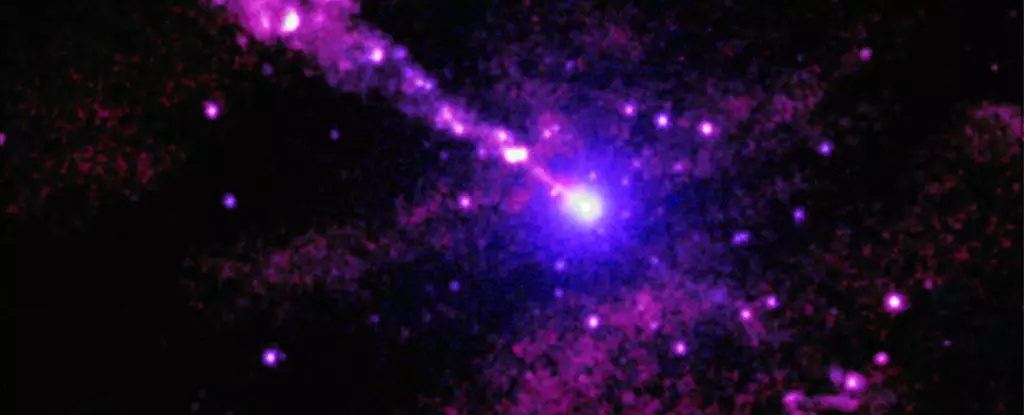In the vast expanse of our universe, galaxies each present unique tales of formation, evolution, and peculiarities. Among these celestial wonders, Centaurus A stands out as a true enigma, offering astronomers a puzzling mystery that has captivated scientific inquiry. Located approximately 12 million light-years away from our home in the Milky Way, Centaurus A is classified as a peculiar galaxy, characterized by a distinct array of features that foster both intrigue and confusion. Understanding this galaxy requires not only a grasp of its structural properties but also insight into the ongoing interactions within its celestial environment.
What sets Centaurus A apart from most other galaxies is its vibrant and tumultuous nature. It exhibits a complex structure, including sweeping dust lanes and an arrangement of dwarf galaxies orbiting around its galactic plane. These distinct features lead scientists to hypothesize that Centaurus A may have formed from the collision and subsequent merger of two or more galaxies in the distant past. The aftermath of this galactic rendezvous has endowed Centaurus A with an active supermassive black hole, actively accreting matter and emitting enormous jets of plasma that extend into intergalactic space.
One particularly astonishing aspect of Centaurus A is the powerful jets of plasma that emanate from its central black hole. These jets are propelled with such force that they create enormous lobes of radio emission as they interact with the surrounding intergalactic medium. Recent observations have heightened interest in these jets, revealing a peculiar phenomenon referred to as C4, where a section of the jet appears to collide with an unknown object. This unidentified entity has sparked a myriad of questions among astronomers: What is this C4? What could it be that yielded such atypical emissions, characterized by a striking V-shaped X-ray pattern?
Located at a distance measurable in thousands of light-years, the C4 anomaly stands out due to its unique emission signature, which cannot be replicated by collisions observed elsewhere within the Centaurus A jets. In such collisions, radio emissions generally appear as indistinct blobs; however, the V-formation associated with C4 indicates a distinct interaction that has not been observed before. Such anomalies demand further scrutiny, as they could reveal crucial information about the processes occurring in the vicinity of supermassive black holes and the mechanics of cosmic jet production.
To grasp the dynamics at play within Centaurus A, we must first understand the mechanics of its black hole activity. When a black hole is deemed “active,” it suggests that it is pulling in matter from an accretion disk—a swirling collection of gas and dust in a gravitational dance around the black hole. Though some material plunges into the void, a significant portion is instead propelled along magnetic field lines, resulting in the creation of powerful jets of particles aimed at the poles of the black hole. These jets can reach astronomical lengths, spanning up to millions of light-years.
Astronomers have utilized tools such as NASA’s Chandra X-ray Observatory to delve deeper into these emissions. The high-energy observations have illuminated the jet dynamics around Centaurus A and led to the unexpected discovery of the V-shaped feature. This marks a significant advancement in our understanding of galactic jets and their interactions with external objects. As the jets move through the cosmos at frightening speeds, they appear to collide with an unidentified entity, sparking distinctive outflows that generate X-ray emissions. Each arm of the V measures approximately 700 light-years long, suggesting a powerful and unusual interaction.
Yet, the exact nature of the interaction remains elusive. Could C4 be a massive star caught in the jet’s path, or is it a complex region of turbulence that influences the jet flow? The challenge lies in the fact that only one arm of the V aligns with the jet’s trajectory, while the other seems obliquely oriented, raising questions about the underlying physics of this interaction.
The mystery surrounding Centaurus A and its enigmatic feature C4 beckons deeper investigation into the behavior of galaxies, black holes, and cosmic jets. As astronomers collect more data across various wavelengths, the objective is to unveil the mysteries that intergalactic phenomena conceal. Each new observation and discovery not only refines our understanding of this peculiar galaxy but may also assist in broader cosmological contexts, including the evolution of galaxies and the role of supermassive black holes.
The insatiable quest for knowledge propels scientists to gaze at our cosmic neighbors with unwavering curiosity. In the case of Centaurus A, the answers, like the cosmos themselves, might only be a matter of time—awaiting the day when we can finally illuminate the obscured facets of this astonishing galaxy. With ongoing advancements in observational technology, the universe’s most profound enigmas, such as that of Centaurus A and C4, will no doubt continue to tantalize and inspire generations of astronomers and seekers of knowledge.

